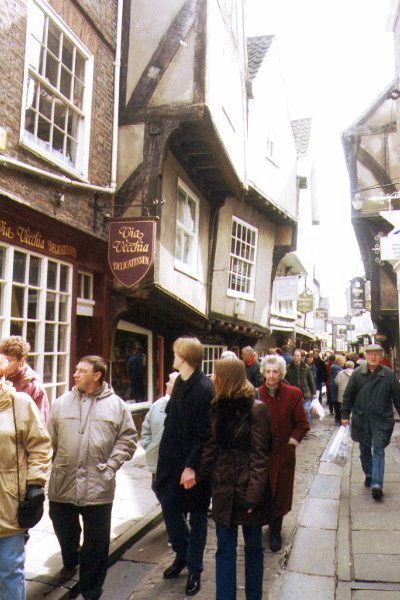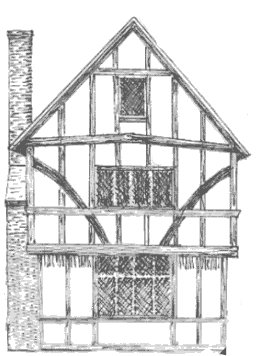

There are very few medieval streets surviving anywhere in Northern Europe, and even fewer with good examples of domestic architecture. But the Shambles in York still has some fourteenth and fifteenth-century houses, which you can see in the picture on this page. As you can see, the ground floors of the houses are quite low (some are in fact beneath the street level), so the first "upper" floor hangs almost at head height above the pedestrian walkway, while the garrets where enterprising students like hende Nicholas rented rooms are placed for excellent proximity to what's going on below. Note how narrow the streets are--one cart wide--and of course, in the Middle Ages, that middle trough would not be paved; it would be a gutter for the local waste to flow through.
Key terms: fabliau, exemplum, frame narrative or framework story, vice, confession, verisimilitude, lerned vs. lewed, Hengwrt manuscript (copied between 1396 and 1400 by Adam Pinkhurst), Ellesmere manuscript (copied between 1403 and 1408 by Adam Pinkhurst, with color illustrations of the pilgrims added by a contemporary painter), Black Death, allusions
Framework Stories
The General Prologue sets out an ambitious framework story for the Canterbury Tales: 29 travelers will tell two stories each on the way down to Canterbury and on the way back, for a total of 116 stories. The contest will be judged by Harry Bailey, the Host of the Tabard, who will award a dinner to the one who tells the best story. Chaucer didn’t complete this design—there are only 24 extant tales we feel safe in attributing to him. These embedded stories are set within the framework—most have prologues and epilogues where the Host and other pilgrims comment on the tale just told. Of course, we have to remember that in a group that big, not everybody would be able to hear the tales being told--but Chaucer has to make us believe (using verisimilitude) that they could be. The framework for the Canterbury Tales is that of a pilgrimage--the allegory being clear to medieval readers that life was a journey or pilgrimage in search of salvation. So the stories told in the Canterbury Tales are those that illuminate moments on a spiritual pilgrimage--both this fictional one and the one that all of Chaucer's readers are making.
The Miller’s Tale
"The Miller’s Tale," of course, is wonderfully funny. This type of tale is called a Fabliau, which is a short tale in verse, usually octosyllabic couplets, dealing with bawdy incidents and low comedy. Fabliaux were a common and important part of French poetry in the 12th and 13th centuries. Many critics consider "The Miller’s Tale" to be the best fabliau in any language. <source> Though they seem to involve lower-class or lewed characters, in fact, most examples of the genre were very literate tales, probably written by lerned University students and clerks like Nicholas for a very well-educated audience. The details--such as Alison's clothing and behavior, or the contents of Nicholas's room, contribute to the verisimilitude of the story--and thus to its humor. It also is placed as an answer to the Knight's very courtly tale of two noble lovers, Palamon and Arcite, and their competition to win the affections of a beautiful noblewoman, Emily. So in many ways "The Miller's Tale" works like a film such as Scary Movie--part of the fun is guessing what other texts, conventions, and audience expectations Chaucer is parodying at any given moment.
The carpenter is deceived by his wife and Nicholas when he travels from Oxenforde to Osneye, where is working on land belonging to the Abbey. Notice that each man travels from a "secular" home to a "holy" destination. Even more puzzling, the carpenter appears to be the most sympathetic character in the tale. He is the only one who shows concern for others (remember he is worried about Nicholas, and when he hears about the "flood" his first thought is about his wife’s safety), and yet he clearly receives the worst punishment and the greatest humiliation. By the end of the tale, he is publicly exposed not only as a cuckold but also as a fool. <source> Chaucer's extensive knowledge of Oxford and university workings is on display in this Tale, which is often used as evidence to suggest that Chaucer at least briefly attended a university.
 The
Miller's Tale exploits the characteristic architecture of a medieval hall
house--the kind of house a successful medieval craftsman might build to show off
his wife. Note that he has servants--they live in the attic along with
Nicholas--and that the carpenter's house has all the latest details, including
locks for private rooms in the attic. This was not entirely common and again is
an index to the kinds of audience and readers Chaucer might have expected for
the Tale.
The
Miller's Tale exploits the characteristic architecture of a medieval hall
house--the kind of house a successful medieval craftsman might build to show off
his wife. Note that he has servants--they live in the attic along with
Nicholas--and that the carpenter's house has all the latest details, including
locks for private rooms in the attic. This was not entirely common and again is
an index to the kinds of audience and readers Chaucer might have expected for
the Tale.
Part of the humor derives from the quality of the details—the realism of the houses and John’s escape devices, the blacksmiths working at night because of the heat, the ‘shot’ window left open for ventilation, etc. This verisimilitude contributes to the humor of the story. At the same time, the very fact that Nicholas is a clerk and Absolon a curate asks us to think about the spiritual values of this community and what kinds of behaviors should be rewarded (as compared to the values that apparently are rewarded).
Another source of humor are the allusions to the Bible embedded in the story. You'll find allusions not only to the story of Noah's Flood but to the parable of the woman taken in adultery, to the Song of Songs, to the Annunciation story, and of course, the story of Absolon.
1) Is there a message about the individual and spirituality in this Tale? If so, what is it?
2) What about Absolon, the priest in training? What does
his behavior say about how people evidence cultural/spiritual values in their
lives? Does Absolon, in fact, turn the other cheek?
3) Alison's role in this tale has garnered a lot of attention. How do you read the character of Alison in this story? What is her most famous line? What responsibility does she bear? (In the Middle Ages, women were regarded as less "reasonable" and less intellectual than men because of traditional teachings. Does this affect how Chaucer portrays her?) What is the significance of that careful description of her, centering around her loins? What aspects or telling details about her does Chaucer focus on? Why is she described as a ‘wench’? , And why does she get off without punishment at the end of the Tale?
4) The clerks who support ‘hende’ Nicholas against John are all graduate students supposedly studying for careers in the Church. Again, what does Chaucer imply about their relationship to their spirituality and to their society?
The Pardoner’s Tale
The Pardoner’s Tale" is an example of an exemplum (plural exempla), a story designed to illustrate a moral principle. This type of story was very popular during Chaucer’s time. Almost all readers, for example, would have been familiar with Gesta Romanorum, or Tales of the Romans, which presented short narratives followed by moral explications. The Pardoner, you’ll notice, tells a tale specifically designed to illustrate the theme of all his preaching, Radix malorum est cupiditas, avarice is the root of evil. If you remember how Æsop's Fables work, you'll understand the idea of exempla.
In the Middle Ages, when people
believed very firmly in Heaven and Hell, the prospect of not spending eternity
in Heaven was a very frightening one. The Catholic Church also taught that there
was a place called
Purgatory, for souls not bad enough to go to Hell but not
good enough to go to Heaven right away. The Church taught that if people prayed
enough for the souls in Purgatory, they would eventually be granted entrance to
Heaven. The Church then sold
indulgences or
pardons
to people
concerned about their salvation; for a suitable donation, perhaps to the
Hospital of St. John in Jerusalem or other institution, the donor was granted a
certain number of days less in Purgatory. Minor Church employees like the
Pardoner had the job of selling these dispensations. The Pardoner, of course,
isn't doing it to save souls, and he is also selling fake pardons, as well as
fake relics and other panaceas. Thus he becomes the target of Chaucer's wrath.
The character of the Pardoner is described with telling
details that would have signified things to his audience—most of them are
associated, in the Middle Ages, with male sterility (eunuchry) or homosexuality—that is, of
life and vitality misdirected or dried up. His tale is one of matching spiritual
sterility—because he views salvation as a commodity that can be sold to the
highest bidder, he is an index of how badly off the Church may have been after
the Black Death. He is not interested in saving souls but in getting money, and
doesn’t care what harm he does to people (either physically or spiritually) in
collecting his ‘take’. His selling of indulgences not only
takes resources away from the community but also promises a false hope of
salvation to people who genuinely want it. He is
condemned not for his lack of heterosexuality but for his cynical attempts to
deceive those people who sincerely and desperately seek salvation (i.e. not for
who he is but for what he does). For an excellent summary of the
Pardoner's character, see the
Harvard
Chaucer pages, which include links to a number of articles on this topic.
Before his tale, the Pardoner reveals and brags about many of his tricks. He seems to want to bring the rest of the group into his confidence. He then tells a wonderful allegorical story about greed. The story, of course, is ironic because the Pardoner is entirely greedy. Note the use of understatement and litote in it.
5) What is the significance of the Pardoner’s silence? What do we learn about him?
6) Why do the pilgrims (almost) give in and buy his wares? What message is Chaucer trying to send to us about our own responsibilities in a world where 'official' spiritual guidance may not be reliable?
Material in blue taken from Dr. Christopher Johnson of Furman University at http://www.fmarion.edu/~drjohnson/JAN22.HTM